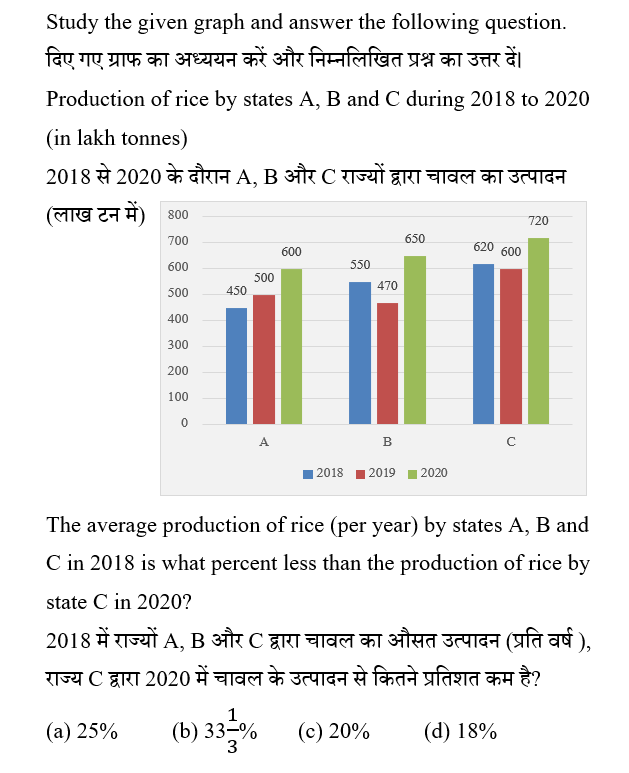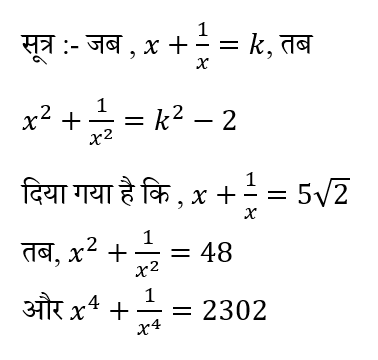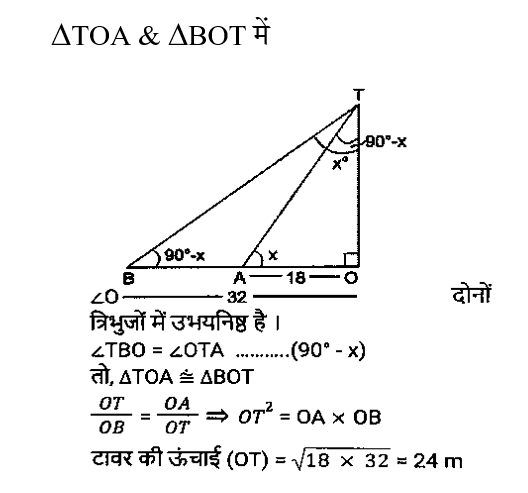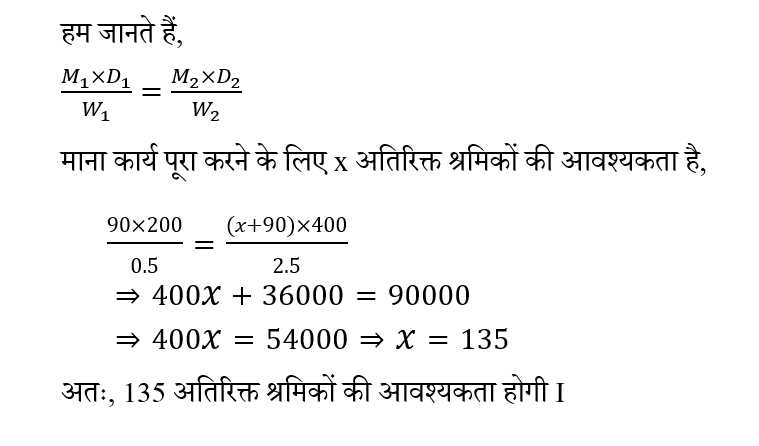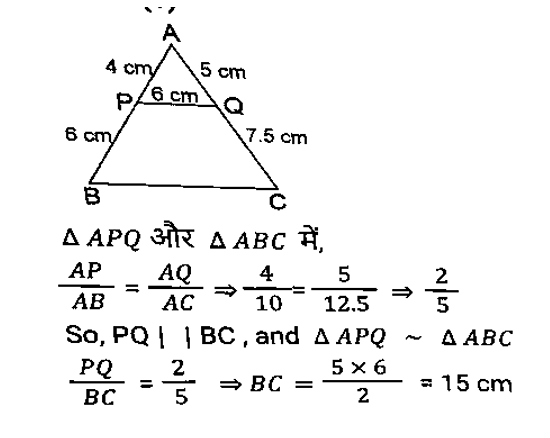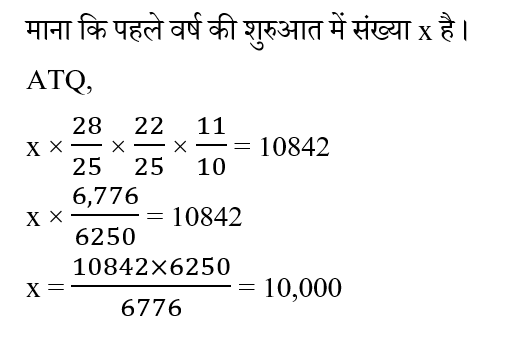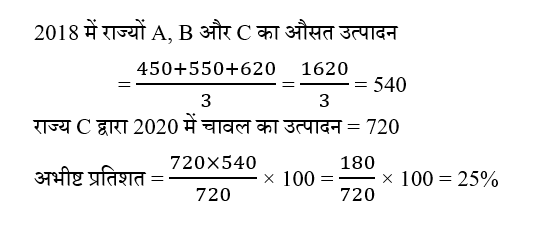Question 1: 
Question 2:
The angles of elevation of the top of the tower from two points on the ground 32 m and 18 m away from its base, situated in the same line, are complementary. The height of the tower is ______.
मीनार के शीर्ष का, भूमि पर इसके आधार से 32 मीटर और 18 मीटर दूर एक ही रेखा में स्थित दो बिंदुओं से उन्नयन कोण पूरक है । मीनार की ऊंचाई ______है ।
Question 3:
The ratio of number of chickens to goats in farm A is 5 : 4 and the ratio of number of chickens to goats in farm B is 5 : 7. Find the ratio of total chickens and total goats present in both the farms, if total number of animals in farm A and B is equal.
फार्म A में मुर्गियों की संख्या का बकरियों की संख्या का अनुपात 5:4 है और फार्म B में मुर्गियों की संख्या का बकरियों की संख्या का अनुपात 5 : 7 है। दोनों फार्म्स में मौजूद कुल मुर्गियों और कुल बकरियों का अनुपात ज्ञात कीजिए, यदि फार्म A और B में पशुओं की कुल संख्या बराबर है।
Question 4:
A civil contractor planned to build an over bridge of 3 km length in 600 days. For this purpose, he employed 90 workers. After 200 days of work, it was observed that only 0.5 km of the bridge was completed. How many additional workers are required to complete the work on time?
एक सिविल ठेकेदार ने 600 दिनों में 3 किमी की दूरी का एक ओवर ब्रिज बनाने की योजना बनाई। इस उद्देश्य के लिए, उन्होंने 90 श्रमिकों को नियुक्त किया। 200 दिनों के काम के बाद, यह देखा गया कि पुल का केवल 0.5 किमी भाग ही पूरा हुआ था। कार्य को समय पर पूरा करने के लिए कितने अतिरिक्त श्रमिकों की आवश्यकता है?
Question 5: 
Question 6:
In a triangle ABC, points P and Q are on AB and AC respectively such that AP = 4 cm and, PB = 6 cm, AQ = 5 cm and QC = 7.5 cm. If PQ = 6 cm, find BC (in cm).
एक त्रिभुज ABC में, बिंदु P और Q क्रमश: AB और AC पर इस प्रकार हैं कि AP = 4 cm और, PB = 6 cm, AQ = 5 cm और QC = 7.5 cm, यदि PQ = 6 cm, तो BC (cm में) ज्ञात कीजिए ।
Question 7:
During the first year, the number of students in a school increased by 12%, decreased by 12% in the second year and increased by 10% in the third year. At the end of the third year, the number of students in it was about 10842. What was this number at the beginning of the first year?
पहले वर्ष के दौरान, एक विद्यालय में विद्यार्थियों की संख्या में 12% की वृद्धि हुई, दूसरे वर्ष में 12% की कमी हुई और तीसरे वर्ष में 10% की वृद्धि हुई। तीसरे वर्ष के अंत में इसमें विद्यार्थियों की संख्या लगभग 10842 थी। पहले वर्ष की शुरुआत में यह संख्या क्या थी?
Question 8:
The sum of the interior angles of a regular polygon is 1260°. Find the difference between an exterior and an interior angle of this polygon
एक सम बहुभुज के आतंरिक कोणों का योग 1260° है । इस बहुभुज के एक बाह्य तथा एक आतंरिक कोण में अंतर ज्ञात करें
Question 9:
Study the table given below which gives the percentage marks obtained by 5 students P, Q, R, S and T in 5 subjects, A, B, C, D and E. The maximum marks for each subject are given in brackets against each subject.
नीचे दी गई तालिका का अध्ययन करें जो 5 विषयों, A, B, C, D और E में 5 छात्र P, Q, R, S और T द्वारा प्राप्त प्रतिशत अंक के बारे में बताती है। प्रत्येक विषय के लिए अधिकतम अंक प्रत्येक विषय के सामने ब्रैकेट में दिए गए हैं।
|
विषय→ छात्रा ↓ |
A (50) |
B(75) |
C (75) |
D (150) |
E(50)
|
|
P |
60 |
76 |
80 |
56 |
52 |
|
Q |
66 |
72 |
64 |
58 |
68 |
|
R |
58 |
84 |
72 |
70 |
74 |
|
S |
78 |
56 |
76 |
48 |
86 |
|
T |
88 |
60 |
72 |
60 |
70 |
What is the average percentage of marks obtained by all the students in subject 'C'?
विषय 'C' में सभी छात्रों द्वारा प्राप्त औसत प्रतिशत अंक क्या है?
Question 10: 